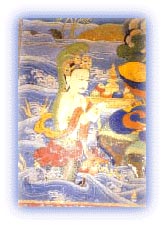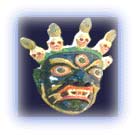Sikkim himalayas
General Info
· Kanchendzonga
· The Teesta Saga
· Zemu Glacier
· Northern Sikkim
Flora and Fauna
People
· Lanchenpas & Lanchungpas
Visual Delights

![]()
The Nepalese community, which repesents over two-thirds of thepopulation, follow Hinduism. The Lepchas continue to have theirtraditional beliefs. They have faith in spirits and in theshamans who cure illnesses and preside over ceremonies duringbirth, marriage and death. The Bhutias practise Buddhism andwere responsible for converting the Lepchas to MahayanaBuddhism. |
 |
| Inside a Buddhist Monastery Credit: Discover India |
Buddhism was introduced in Sikkim primarily due to a strifeamong the Buddhists of Tibet in the 15th and 16th centuries.The root of this strife was the reformation brought about inTibetan Buddhism by Dipankar Srijana or "Atisha". He was anIndian monk who visited Tibet in the 10th century. He led amissionary journey in 1042 and preached celibacy and moralabstinence and opposed the tantric arts. The Gelugpa or thereformed order, headed by the Dalai Lama, originated duringthis period of time. The unreformed or the old order was theNyingmapa, whose source of inspiration were the great mysticyogis of the time. The Nyingmapa trace their origins to thegreat yogi Milarepa. They resisted the reform of the Gelugpaand maintained their beliefs in the tantric practises.
 |
| Buddhist Mural Credit: Discover India |
The gap between the followers of the two sects deepened. Intime, the Gelugpa sect, headed by the Dalai Lama, became theprominent influence in Tibet, while the Nyingmapa sought refugein Sikkim.
The major festival in Sikkim is the Phanglhapsol festival. Onthis occasion, masked dances are performed by the people inhonour of Kanchenjunga, the presiding deity and the mountain.This festival lasts for two days.
The Namgyal Institute of Tibetology in the region has afantastic collection of Tibetan books -- the largest in thispart of the world. Most of the Buddhist monasteries are bigrepositories of artifacts, wall paintings, tankas (religiouspaintings) and bronze images.
All rights reserved
